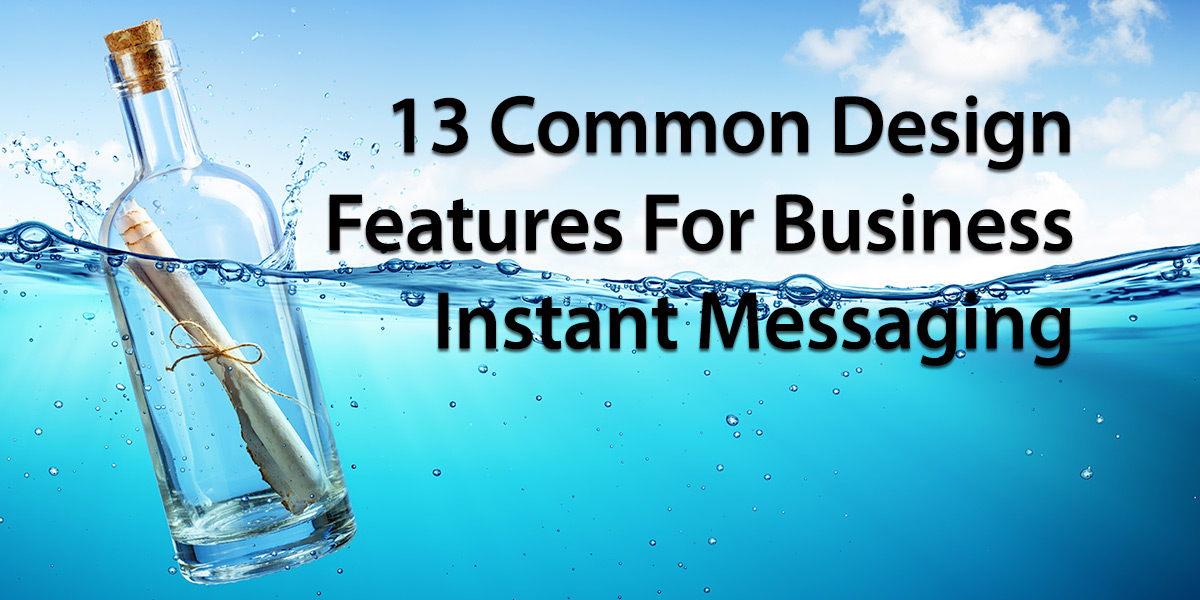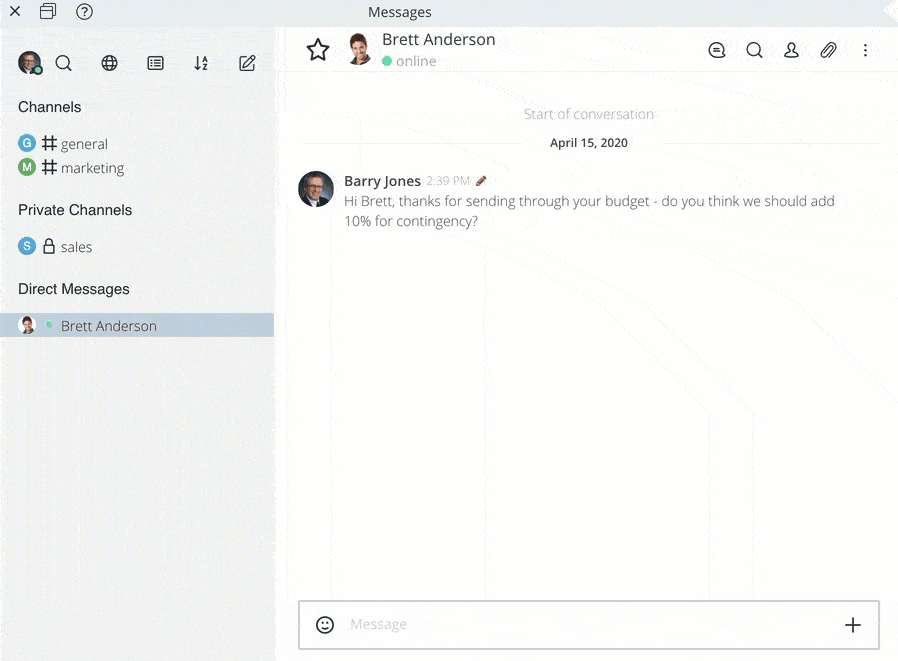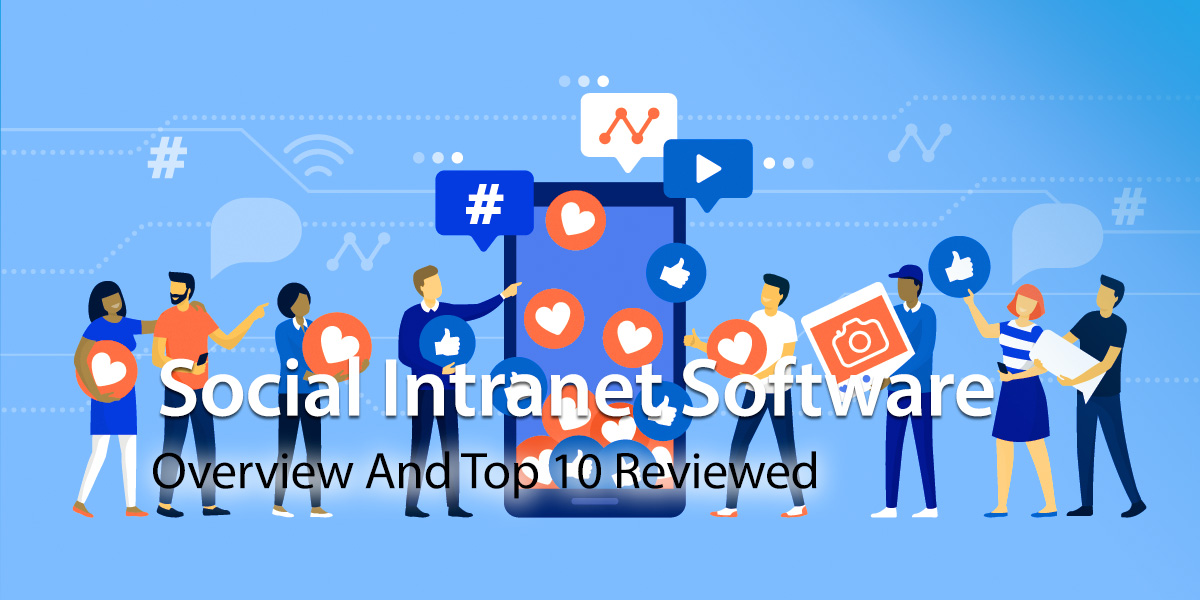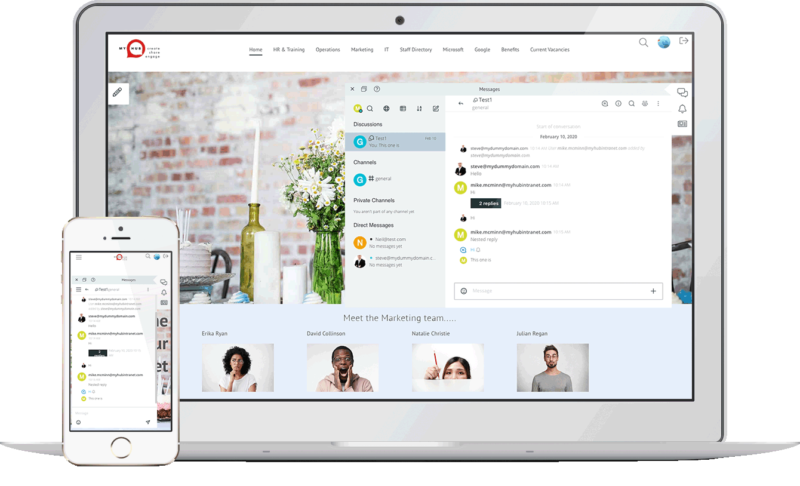Fast, responsive, and relevant, instant messaging (IM) is a game-changer for many businesses. When collaboration and agile decision-making are vital, IM has much to offer companies.
Once seen as the preserve of teenagers, IM has moved into the mainstream. And so, for many of us, IM is the go-to platform for keeping in touch with friends and family. In 2021, there were 7.7 billion monthly active IM users worldwide, with WhatsApp, Facebook Messenger, and WeChat the most popular.
Engaging and already familiar to staff, it’s not surprising IM’s popularity as a communication channel has exploded among businesses. In fact, according to one survey, 43 percent of employees are using instant messaging platforms for work.
And with hybrid models of working now replacing traditional office setups, IM has become a necessity.
So, if you haven’t got IM or team chat in your company, now is the time to do so. Here we explore the 13 common design features your IM platform needs to have.
Let’s get started with a definition of IM.
What Is Instant Messaging?
IM is real-time text-based communication between users within a network. The message arrives instantly to the recipient’s smartphone, tablet, computer, or laptop. Although primarily text-based, you can also send graphic, audio, and video files plus Google or MS docs.
A Brief History Of IM
IM has been around for a surprisingly long time. In 1996 Mirabilis was one of the first companies to launch its ICQ IM software. AOL’s version AIM followed in 1997, YAHOO! Messenger in 1998, and MS Messenger in 1999, while Skype entered the market in 2003.
Nowadays, there are a host of IM platforms, with WhatsApp being the market leader. As of January 2021, WhatsApp had two billion monthly users worldwide.
Benefits Of IM For Business
Before we get into the detail, let’s take a look at the benefits IM has to offer businesses.
Stay Connected
IM makes connecting staff and staying in touch with customers easy. Regardless of location, IM provides real-time communication. And so, remote workers can feel like part of the wider team. And technical or sales staff out on the road can quickly get answers to issues, thereby providing better customer service.
Support Collaboration
Public or private IM chats make team collaboration a simpler task. Project teams can keep updated, share resources, and problem-solve quickly and easily.
Save Time And Effort
IM eliminates the time lag involved in emails and also does away with annoying voicemail phone tag. The result? Less time and effort spent on communicating and chasing colleagues. Plus, as most workers will already be using IM in their private lives, people will feel confident using it straightaway. This means drastically reduced rollout and training costs.
Increase Productivity
Research confirms that IM at work supports faster decision-making and quick resolution of simple queries. And it also enhances creativity with a rapid flow of ideas to which all participants can contribute.
Swift Dissemination Of Critical Messages
Need to urgently let the team know about a police incident or cyber threat? Unlike email, which can sit unopened in an employee’s inbox for days, IM is instantaneous.
Improve Customer Service
IM helps you serve the customer more efficiently and effectively. For example, customer-facing staff with a query they don’t know the answer can simply ping an IM to colleagues. Seconds later, the issue is resolved, and the customer is none the wiser. What’s more, many businesses also use IM to engage directly with customers.
Empower Staff
Employees can choose who they follow and what channels they want to subscribe to. Plus, on IM chats and channels, everyone has access to information. And everyone has the same right to participate. This inclusivity often ensures companies benefit from team members’ ideas who might not otherwise have felt they could contribute.
Increase Employee Engagement
IM is fun to use, making it a popular feature with staff. This high user appeal, together with increased empowerment, will impact your overall rates of employee engagement.
More Agile And Effective Decision-Making
The ability to respond quickly is a crucial differentiator for top-performing businesses. IM supports swifter decision-making. Plus, it allows for context and real-time discussions in problem-solving and agreeing next steps. So, for fast-moving projects requiring fast communication and the ability to make decisions on the hoof, IM is hard to beat.
Reduce Information Overload
IM enables you to be more relevant in your communications. As a result, employees can invest their time in what really matters to their work. And the noise of irrelevant communications is minimized.
13 Common IM Design Features
So, what are the common features every business IM platform should have? Let’s explore those vital must-haves.
1. Public Or Private Chats
The IM platform should allow for both public and private chats. For example, a team or department may have a public discussion that everyone can access to share news and updates. However, a project team working on the new marketing strategy will want a private chat for team members only.
2. Channels
Increase relevancy and discoverability with #channels. These are perfect for overview topics such as #HR, #Marketing, or #Sales. You can toggle these channels as public or private. Employees simply select and follow #channels relevant to their work or interests.
3. Threads
Threads are an excellent choice for thematic, short-term messaging. For example, it could be arrangements for the Christmas team party or feedback on the new employee wellness package.
4. Direct Messaging
Private messages between colleagues, these IMs can be sent direct to desktops or mobile devices.
5. Mentions
The @mentions feature makes it easy to share updates and information, assign project tasks or involve workmates in the conversation.
6. Social Features
Social features are hugely popular with users and help drive engagement. So, whether it’s emojis, pinned messages, or #coffeebreak channels, make sure your IM system allows staff to connect informally as well as formally.
7. Online Status
Find out who is online and available to chat with an outline status tag. All you need to do to start a conversation is click on a name. The availability status should also alert you to colleagues who are busy, away, or unavailable to chat. And so, if you need to concentrate on an important task, you can simply turn your status tag to busy.
8. Easy Search
Finding that vital piece of information within the IM platform shouldn’t be a massive job. What’s required is an advanced search that works across all channels, threads, and conversations. The search should be customizable by topic, date, or alphabetical tags. Ideally, it should also be possible to print a written record of conversations.
9. Customizable Notifications
As well as customizing your availability status, you can personalize your notifications. Decide when and how you receive IM notifications in your settings. And you can opt to mute or alarm notifications for specific channels and threads as you want.
10. File-Sharing Capabilities
It’s vital to have the ability to attach files and documents to the chat. Make sure your IM platform provides video and file sharing.
11. Single Sign-On
Ideally, your IM system should be integrated with the company intranet or other enterprise systems already in use. Gateway access to all systems is a valuable feature. It means staff won’t be juggling different apps and screens.
12. Security Features
Security of vital personal and company information should be a priority. Make sure you have the necessary network and computer security in place. At a minimum, you should have end-to-end security, firewalls, and encryption. Some companies also set up virtual private networks as an extra precaution. There have been plenty of reports of hacks and viruses affecting popular platforms like WhatsApp and Facebook Messenger. Be sure to thoroughly check out the security aspects before signing up for an IM service.
13. Simple To Set Up
Last but by no means least, the best IM platforms are simple to set up and easy to use. Opt for an intuitive IM system that doesn’t require a degree in computing to get up and running.
IM For Business: Potential Pitfalls To Avoid
IM undoubtedly has much to offer businesses. However, there are some potential downsides. Here we identify the three most common pitfalls and how to avoid them. After all, forewarned is forearmed.
Too Much Noise
There is the possibility that far from eliminating all that noise from irrelevant communications, IM makes it worse. With so many threads and channels to follow, there’s a danger employees will become overloaded. If this happens, then there’s every chance your staff will switch off IM altogether.
Your IM platform must make it easy for employees to organize chats by topics. Determine membership of groups by real workplace teams and projects. And ensure managers know to keep an eye on the channels and threads within their remits. The notifications feature is also essential here. Staff should have control over how and when they receive notifications.
Too Many Distractions
There is a widespread perception that IM is inherently distracting. All those conversations and endless notification pings just distract workers from the job at hand, right?
However, when it comes to workplace productivity, research suggests that IM may not be the distraction once thought. For example, in one survey, 30 percent of participants said that it was not distracting at all. And a further 51 percent that it was only minimally distracting.
Interestingly, in the same survey, participants said that one of the benefits of IM was fewer emails and calls to deal with. Therefore, it seems the benefits IM offers most employees outweighs the occasional distraction.
Too Much Idle Chit Chat
Another common perception about IM is that employees waste time exchanging memes and GIFs or engaging in idle chit chat.
However, it’s important to remember that for remote workers, IM can be a lifeline. Loneliness and isolation are real issues for many home workers, especially single people who live alone. IM provides instant access to work colleagues and has replaced the water cooler for many telecommuters.
The bottom line is that employees will chat about the baseball results or the weather regardless of IM. In fact, social interaction and personal relationships are the foundations of every successful business.
Instead of trying to stamp out banter between the team, take control by setting up a #timeout channel. That way, you ensure workers have opportunities to build strong workplace relationships. And you can keep an eye on how the channel is working to ensure it isn’t abused. Similarly, why not encourage staff to down tools from time to time. Instead, workers simply connect with each other in casual conversation for 15 minutes at the start or the end of the day.
Chat-Integrated Intranets
So, what’s the best IM system for your company? When it comes to IM’s 13 common design features, a chat-integrated intranet ticks all the boxes.
Platforms such as MyHub’s team chat come with all those essential features, including secure public and private discussions, threads, and @mentions. Easily searchable, your employees can cut the noise and invest their time in what really matters.
And the good news is IM is included in the standard fee – there’s no extra charge. So, you can take advantage of all the productivity and time-saving benefits of IM. And at the same time, you will enjoy the many other business benefits an intranet has to offer. An intranet is a comprehensive solution offering enhanced internal communications, streamlined processes, and better information sharing, to name only a few of the great features. So, sign up today for a free demo or 14-day trial and explore what’s on offer.










0 Comments